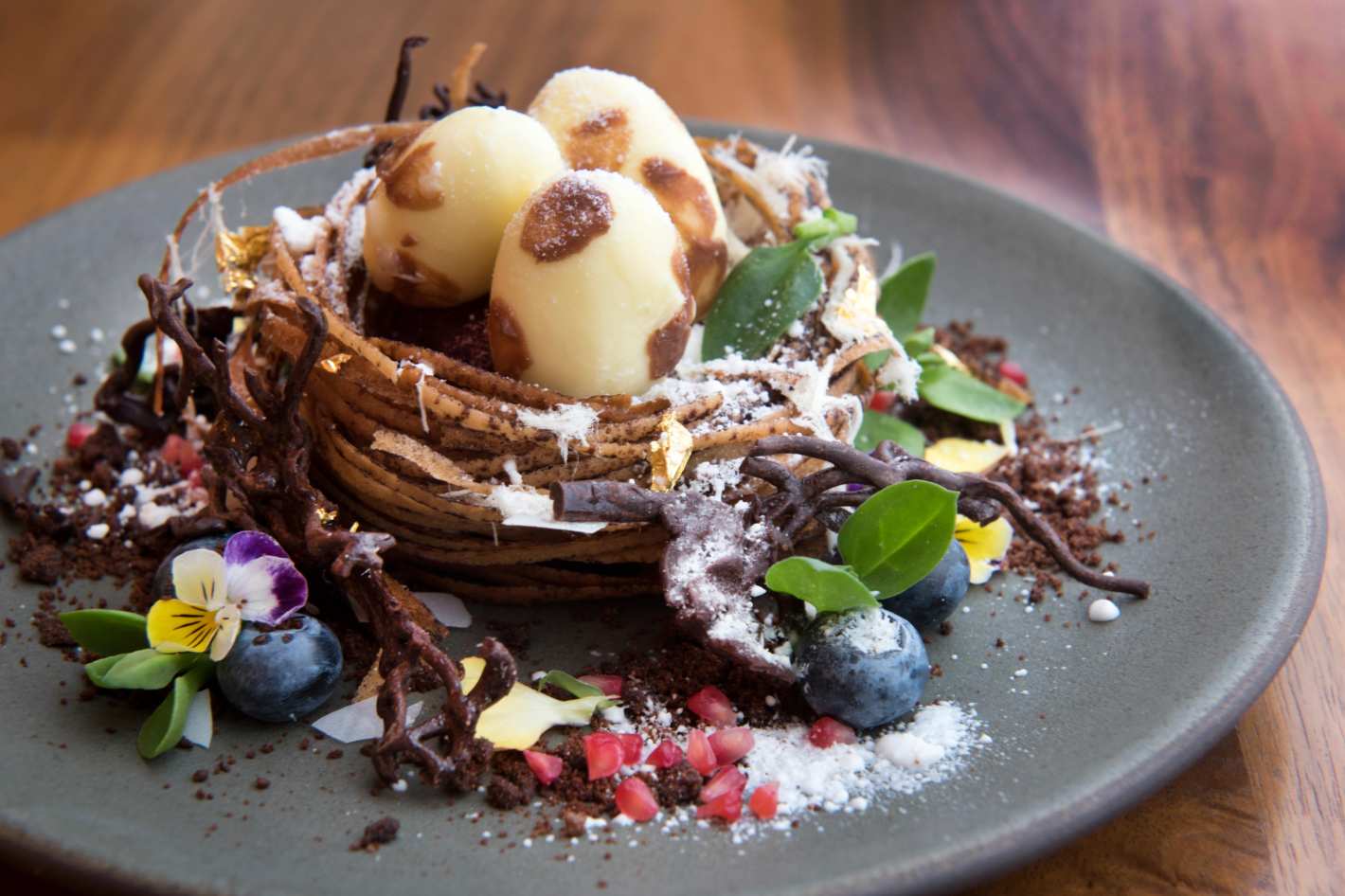David Posey discovered the power of Instagram almost by accident. Before his heavily anticipated new restaurant Elske opened in Chicago, Posey posted a picture to his personal account, a shot of his hand holding the new key to the building. Surprise: The post racked up likes, further stoked excitement about the project, and caused the restaurant’s still-dormant Instagram account, which hadn’t yet posted a single photo, to flood with followers. When Elske opened, Posey and his partner, co-owner and pastry chef Anna Posey, built Instagram right into their work routines. Anna handles the composed Instagram posts; David handles the relatively new, and more fleeting, Instagram Stories.
This dedication to Instagram won’t surprise anyone who’s seen lines snaking around city blocks for things like Black Tap milkshakes, cookie-dough stores, and rainbow bagels. Historically, however, the Instagram Effect has largely existed in the realm of cheap eats and novelty foods. It’s only been recently that esteemed chefs have embraced the platform’s marketing potential, designing their dining rooms and inventing menu items tailor-made for Instagramming.
“I’m realizing more about its power every day,” says Mario Batali, who oversees 27 properties around the world, and who will probably have opened a few more restaurants in the time it takes you to read this. Batali has watched Instagram become an integral part of his restaurants. At his smaller restaurants, such as Casa Mono, Batali says that the impact of a great Instagram post can be immediate: “We often post about a daily special inspired by the Greenmarket — say soft-shell crab with ramps,” and then “see people walk in to order it,” as a direct result of having seen the post.
It’s a small thing, but it’s something of a seismic change in fine dining. It wasn’t so long ago that chefs at high-end restaurants banned pictures — even cell-phone pictures — from their dining rooms. Batali used to forbid taking photos in the dining room at Babbo. He says that today his stance has changed not because of any grand philosophical shift, but because new technology makes taking photos less intrusive: “In the case of a blogger in 2008, it meant a light kit and a tripod — it would disturb every other person in the dining room,” he remembers. “Now, it’s un-invasive and requires no lighting at all.”
The idea that restaurants would allow pictures at all very quickly gave way to owners actively courting Instagram attention. The chefs Grub spoke to for this story were reluctant to put hard numbers against a viral dish — and it likely varies too much among restaurants and dishes — but it’s undeniable that new restaurants’ lighting is designed to make food look better (we’d wager all those white-marble tabletops are no coincidence, either), and chefs now craft dishes specifically for social-media appeal. It’s the golden age of food porn. Batali himself describes the jamón de la Bellota globe — slices of Spanish ham wrapped around a spherical candle that burns with a lardo flame — at La Sirena as an “Instagram juggernaut.” Another dish, large-format paella served tableside, “is what used to be called a Kodak moment — now it’s Instagram fodder.”
Emma Bengtsson, the executive chef at Aquavit in New York, says she wasn’t aiming for social-media fame, but also wasn’t surprised when one of her desserts, the Arctic Birds’ Nest — an edible “nest”adorned with chocolate twigs, freeze-dried raspberries, brownie dirt, shredded halvah, and fresh flowers — became a viral sensation. “I don’t think any of us were surprised by its popularity — it’s such an intricate dessert,” says Bengtsson, who also credits an ingredient that had its heyday in the ’80s: “A little gold leaf doesn’t hurt, either.”
Bengtsson, though, says her approach is less about creating dishes specifically for social media, and more about evolving the style that has always informed her food: “The importance of plating is not anything new,” she says. “With every dish, we strive to create a composition so beautiful that you almost don’t want to touch it … whether it’s going on Instagram or not.”
Enrique Olvera, who runs Cosme and Atla in New York City, has proven repeatedly to have one of the industry’s most finely tuned instincts for which dishes will make an impression on Instagram. He claims not to have changed his cooking style for social media, but Cosme’s duck carnitas and its signature dessert — corn-husk meringue with corn mousse — are both like the gold standard of Instagram hits, continuing to show up on feeds all over the world.
Olvera says that kind of Instagram success can be a double-edged sword. Restaurateurs must now live up to expectations raised by carefully composed, heavily filtered pictures of their best dishes. Consistency has always been highly prized in the world’s best restaurants, and now chefs are serving diners who have a picture of each dish’s Platonic ideal open on their phones, comparing it to the meal they’re eating in real time. “It is a powerful tool to attract people to your restaurants,” Olvera explains, “but it doesn’t end there. The food and experience have to surpass any expectations built up by online imagery.”
Despite their reservations, most high-end chefs have embraced social media wholeheartedly. Vartan Abgaryan, the chef and partner at 71Above in downtown Los Angeles, says that he has yet to see any real downside to Instagram in his kitchen or dining room. At first, he was charmed when he noticed people tagging their friends to make dinner plans in the comments of the pictures of food, before he realized what a powerful marketing tool was at his disposal and hired someone full time to manage and monitor his restaurant’s Instagram presence.
Abgaryan has put a lot of thought into what makes a dish a hit on the internet: “It has to actually get someone to stop for a moment. There are some very beautiful food pictures and they do nothing, then a picture of a single oyster could make you stop and really take a look.” Whatever he does, it works. That lone oyster has become one of the restaurant’s most Instagrammed dishes. And even if you have never even heard of 71Above, it’s likely you’ve seen its popular dish of blonde morels, peas, Parmesan cream, hazelnut, and smoked honey and sorrel on your Instagram feed.
You’ve also, perhaps, seen a few knockoffs of that morel dish, too. In the dark ages before Instagram — in 2009, for example — chefs would have to go to the restaurants themselves, or wait until a cookbook came out, to experience a dish or technique that had spread by word of mouth. “Now,” Posey points out, “Noma posts a new dish, and you can start to see copies within days.” For better or worse, part of the allure of high-end dining has always been a certain level of mystique and exclusivity. Fine dining is, by design, not for everyone. Armchair eaters watch entire tasting menus unfold on their phones, and take video tours of storied dining rooms they know they will never visit. Even if you didn’t land a coveted table at Noma’s Mexico pop-up — or have $2,000 lying around to bankroll the experience of traveling to Tulum and eating there — you were never more than a few taps away from seeing the full expanse of the dinners there.
It can be a satisfying, if frustrating, vicarious experience to scroll past perfectly coiled octopus and awe-inspiring grilled pumpkins. Along with the usual pangs of hunger were sharper pangs of FOMO. I’ll admit to looking at probably hundreds of pictures, and the slight depression that came with knowing I’d never actually eat any of it quickly set in, reminding me of something Bengtsson said when we spoke: “You can’t taste a raspberry through the phone.”



